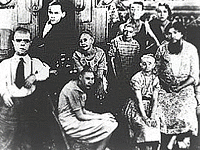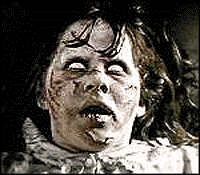

 |
Nosferatu Although the vampire in contemporary film and fiction has become a sex symbol, an attractive and seductive presence, Werner Herzog offers a far different take on the Dracula legend. Actor Max Schreck's grotesque, demonic portrayal is what a such a creature of the night should look like, with its sunken eyes, devil ears, and wicked talons. This film has the feel of nightmare from which one cannot awaken. |
 |
The Phantom of the Opera Few moments in cinematic history can equal the effect that the unmasking of the Phantom (Lon Chaney) had on film audiences. The makeup worn by Chaney is a part of the archetypal horror mystique that pervades the collective unconscious of generations of movie-goers. At last count, this film has prompted six remakes (seven, if you count the rock version) and a long-running stage musical that is about to made into another motion picture. |
 |
Dracula With Bela Lugosi's classic impersonation of a vampire, the monster's image was transmuted from hideous demon to a charismatic, cultured, well-dressed aristocrat who cultivated a female following of beautiful, sensuous, and voluptuous mistresses of the night. With few exceptions, the sexy image created by Lugosi set the mold for the portrayals of vampires thereafter perpetuated in hundreds of cinematic, stage, and print presentations. Although the film is stylized by contemporary standards, the sets, lighting, and mood remain solidly spooky. To me, this film has an enchantment and creates an almost ritualistic compulsion to watch it over and over: Say the lines with me:"I never drink wine." "I am Dracula." "Listen to the children of the night." "Flies! Flies!" |
 |
Frankenstein Boris Karloff gave soul to a grotesque patchwork human made up of the body parts of criminals and assorted corpses stolen from graveyards. The sets of the Castle Frankenstein are darkly magnificent and strangely comforting, as if disturbing memories frightening, yet somehow nurturing to the psyche. This is another movie that I can watch again and again, shouting aloud with the triumphant Dr. Frankenstein (Colin Clive), "It's alive!" Although the story has been given dozens of different cinematic takes with even the great Robert De Niro enacting the monster, the original still has the magic. |
 |
The Mummy Brendan Fraser is a fine comedic actor, and the special effects in the current mummy films are awesome, but I like my tales of ancient Egyptian tombs and mummies played straight. And an ageless story of long lost lovers reunited doesn't detract from the chills. Once again, Karloff is transformed into a classic monster that has little boys and girls checking their closets at night. |
 |
Freaks Horror film master Tod Browning's film about a traveling sideshow was severely cut in the United States and banned in the United Kingdom for over 30 years. Warning: Bizarre, eerie, and utilizing a cast of real-life sideshow "freaks," this is a movie that may take up unwanted residence in your psyche on a long term basis. |
 |
Island of Lost Souls Remade as The Island of Dr. Moreau in 1977 with Burt Lancaster and again in 1996 with Marlon Brando, neither of those great actors came close to the original portrayal of Charles Laughton as the scientists who seeks to create humans out of animals. This film, with its "house of pain," its chant of "what is the law?", and its allegedly noble experiment that becomes an abomination, is a horror classic. |
 |
The Haunting The Robert Wise version of The Haunting ( an adaptation of Shirley Jackson's novel, The Haunting of Hill House) has become one of my favorites for its portrayal of a serious investigation of haunting phenomena. Although the motion picture contains a number of chilling scenes, the spirits themselves are ambiguous, as well as frightening. Director Wise uses camera angles and lighting techniques that emphasize a sense of a terrible reality within a surrealistic world of the supernatural. A superb cast includes Richard Johnson, Julie Harris, Claire Bloom, and Russ Tamblyn. |
 |
The Uninvited As one who has studied and investigated the paranormal for over 50 years, The Uninvited remains, in my opinion, one of the most authentic depictions of haunting phenomena on film. Ray Milland and Ruth Hussy do a splendid job of portraying two intelligent, rational people, who must deal with a place occupied by an evil entity. Gail Russell (a lovely, tragic actress who later committed suicide) plays a young woman whose mysterious past is inextricably linked with the old house and the restless spirits within its dark corridors. Directed by Lewis Allen, the film is extremely subtle in presenting the spirits, and therein lies much of its power to seize the imagination and to provoke genuine chills. |
 |
The Exorcist Critics and audiences alike agree that author William
Peter Blatty and director William Friedkin succeeded in devising what may
be the most frightening film ever made. In June 2001, the American Film
Institute released its list of the top "100 Most Thrilling American
Films," naming The Exorcist Number Three, ranking below Number
Two, Jaws, and Number One, Psycho. |
 |
Psycho This film still packs a chilling wallop--in spite of the passage of time, three sequels, and countless imitators--and well deserves the American Film Institute's ranking of the Number One Most Thrilling Film. Alfred Hitchcock sucker punched the audience by having Janet Leigh, one of the most glamorous and likeable leading ladies of the 1950s, check into the Bates Motel and step into a fatal shower with a knife-wielding homicidal maniac. Since her death occurred within minutes after the opening credits, shocked moviegoers wondered how the movie could go on without its star. And then there was Tony Perkins, a teen idol of the day, who played against his shy, awkward boy-next-door image by running around a big creepy house, cleaning up after his bloody mama's murders, and suffering from a little too much misguided maternal devotion. I was teaching high school when this film was released, and I heard many of my students vow that they would never again step into a shower after viewing Ms Leigh's shocking fate. |
 |
Invasion Of The Body Snatchers While Invaders from Mars (1953) remains in many movie-goers, memory as one of the most frightening films of their childhood, Invasion of the Body Snatchers developed the theme of aliens possessing family and friends to an even higher degree of paranoia. In Invaders from Mars, the extraterrestrials attached themselves to their victims, body and took control of their minds. In Invasion of the Body Snatchers, the ETs brought strange pods with them from their alien world which grew into exact likenesses of those humans whom they replaced. Perhaps what made both films so terrifying to young people was the premise that one's parents, teachers, and friends could be taken over by alien life forms and work toward a nationwide conspiracy. Invaders and Body Snatchers were released during the paranoia of the Communist hysteria provoked by Senator Joseph McCarthy and the House Committee on Un-American Activities during the 1950s. Perhaps such an atmosphere of national distrust may have contributed to the success of these films, but the unsettling concept of aliens slowly taking over Earth through the possession of human bodies became firmly implanted in the psyches of millions of men and women who now looked even more suspiciously at the skies above them. |
 |
The Thing (From Another World) Some social historians argue that the UFO "craze" began when the threat of nuclear war with the Soviet Union hung like a black cloud over the world, and many people were desperate to believe that some force from the skies could appear and deliver Earth from nuclear annihilation. There was no alien deliverance offered in Howard Hawks, The Thing , which told the story of a small group of Air Force personnel and scientists stationed at an isolated outpost near the North Pole who must deal with an extraterrestrial creature that needs their blood in order to survive. The film was a thriller that steadily built tension and frighteningly portrayed how helpless humans might be at the hands of a single powerful alien life-form. I saw it on Halloween night in 1951 when I was a sophomore in high school. I went straight home after the film ended, looking cautiously over my shoulder every step of the way. |
 |
Poltergeist In Steven Spielberg's & Tobe Hooper's film, poltergeists are disembodied spirits who don't know they are dead and who need a guide to take them into the next plane of existence. Steve and Diane Freeling (Craig T. Nelson and JoBeth Williams) move into a new home which unknown to them has been built over a graveyard. The tension in the film centers on little Carol Anne (Heather O,Rourke), who announces that "they're here," shortly before the entities pull her into a spiritual vortex. The Freeling family efforts to reclaim Carol Ann from the spirit world create a film of unrelenting suspense. While purists may carp that the special effects were overdone, Zelda Rubenstein, as the diminutive medium Tangina Barrons, is a believable guide into the unknown, a role that she reprised in Poltergeist II: The Other Side (1986) and Poltergeist III. |
 |
The Omen In Rosemary's Baby, (1968) an unsuspecting young wife (Mia Farrow) is selected to bear the Antichrist after her husband (John Cassavetes) makes a pact with Satan. As the film ends, we only get a quick peek at the infant's reptilian pupils. In The Omen series we are able to follow the Antichrist from early childhood to his position of wealth, power, and charismatic mastery as an adult. Although certain scriptural references to the Beast, 666, and what some Christians refer to as the End Times are not authentic, the film unfolds in a suspenseful and convincing manner. Gregory Peck, as the unsuspecting surrogate father of the Antichrist, is warned of his son's true identity by a number of priests and other individuals, including his wife (Lee Remick), who all meet untimely ends. Although Peck initially considers such warnings as the babble of religious fanatics, he is shocked to discover the numerals "666" on his son's scalp, and he finally resolves to do whatever must be done to thwart Satan's master plan from being accomplished. In spite of a valiant effort on the part of the father, who now concludes that his true son was murdered and supplanted by the disciples of the Antichrist, the demon seed continues his destructive path to world domination in two sequels. |